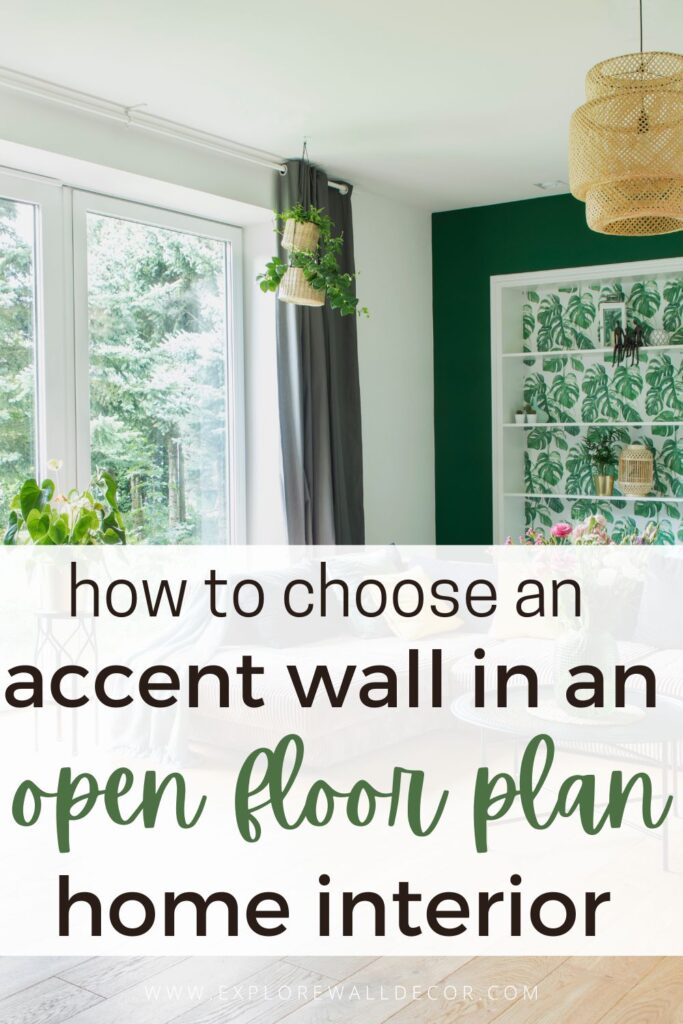Sprucing up your open floor plan and looking to create visual interest? An accent wall is a fabulous idea — but not necessarily the easiest one when it comes to decision making! First, you’ll need a little inspiration before you can successfully complete the project.
Painting an accent wall in any space is quite a task, but open floor plans require another level of skill and preparation. One wrong choice, and you’ll be regretting it 24/7.
Whether you’re cooking in the kitchen, devouring a meal at the dining table, or lounging on the living room couch, you’re confronted with that one wall you screwed up. Yikes!
If you’re hoping to design a stunning accent wall for your open floor plan, look no further than this blog post! Here’s your comprehensive guide on how to choose an accent wall in an open floor plan, color suggestions, tips, and more!

This post may contain affiliate links and we may earn commissions when you click on the links at no additional cost to you. See our disclosure policy for more details.
What Is An Accent Wall?
Before heading into the details, let’s get the basic definition out of the way: An accent (or feature) wall is an interior wall that has a different design from the rest of the room.
It may have a completely different color, such as a bright yellow wall in an otherwise gray interior. Alternatively, it can be the same color in a darker shade. For example, a dark pink wall in a light pink room.
Accent walls may also be different in terms of texture or material. That is to say, they may have textured wallpaper — or may be built using paneled wood, such as a slat wall.
The end goal is simply making one wall stand out amongst the others. Let your creative juices flow, and the possibilities will be endless!
Why Do You Need An Accent Wall In Your Open Floor Plan?
Because open floor plans are so large and, well, open, it’s easy for them to lack coziness or personality. They can even begin to look lifeless and cold. In such a scenario, accent walls are to the rescue!
Accent walls add a pop of pizzazz and character to a bland and boring room. They also allow you to bring a color from another element, such as a painting or a rug, to the walls.
And because open floor plans may appear disjointed at times, this factor helps improve the coherence of the space and creates connections between various design elements.
Additionally, they offer a fun way to showcase your personality in your interior. Use the colors (or materials and textures) that reflect who you are and visually narrate your personality to your visitors!
How To Choose An Accent Wall In An Open Floor Plan
Accent walls are cool, sure, but here’s the problem. How do you choose one wall to accent when rooms are, quite literally, flowing into one another? Which wall will create the most impact and help the space feel more pulled together?
Generally, the right wall to accent would be the first one you see as you walk into the space. But because this is not so easy for open-plan spaces — that bring together multiple walls and rooms — here are additional points to consider:
Accent An Existing Architectural Feature

Highlighting one (or more) architectural features is often the natural choice.
Some features to look for:
- Built-ins
- Cabinetry
- Windows
- Bookshelves
- Fireplaces
- Alcoves
Select any of these architectural features and choose the wall behind it to accent. This ensures the different design of the wall doesn’t make the space feel “broken” and keeps the ambiance more collected.
Add Additional Architectural Features
If your space lacks significant architectural features, consider adding your own. If you have a fireplace, flank it with bookshelves. Or, simply add in recessed shelving like this:

You could either paint the shelves the same color as the accent wall to maintain cohesiveness, or you could wallpaper behind the shelves, then paint the rest of the wall with a coordinating color.
Pro Design Tip: Amazon has lots of fun options for peel-and-stick wallpaper, which is quick to install and easy to remove later on.
Opt For The Wall With Custom Lighting
If you have wall-mounted custom lighting fixtures, such as sconces or vanity lights, consider accenting this wall. This will help your custom lighting grab the attention it deserves and, paired with the accent wall, become the focal point of the space.
Choose A Room To Highlight
If your open floor plan merges, say, the kitchen, dining, and lounge, then accent a wall in the room you wish to draw attention to. For most folks, that would be the living room.
If you’re a devoted chef and have an interesting feature to flaunt in the kitchen (such as a wine rack), you may wish to divert attention by accenting a kitchen wall.
Think of your lifestyle and choose the accent wall in the space you want to attract the most attention to.
Make Sure The Wall Is Symmetrical
The wall you accent will be the center of attention, so it should have good symmetry. In an open floor plan, you can find walls of all types. Be sure to avoid choosing ones with slopes or other awkward niches.
Consider The Fifth Wall
Can’t find the perfect wall to accent? Consider the fifth wall — the ceiling. Different-colored ceilings, especially those with dark colors, can make the room appear cozier. And one thing an open floor plan almost always needs is coziness!
However, dark colors aren’t usually ideal for low ceilings. White would be a better option for these as it creates the illusion of more height.
Color Suggestions For Open Floor Plans
As a rule of thumb, the color palette for your open floor plan should include either three or five different colors (one light color, one or two neutral colors, and one or two supporting colors). Out of these, one will be the hue you choose for the accent wall.
Here are a few color palettes suitable for open floor plans:
- White, beige, and navy blue
- Dark gray, light gray, and yellow
- White, cream, and pastel pink
Tips For Creating An Accent Wall In An Open Floor Plan
Before winding up this blog post, here are a handful of tips to remember while creating an accent wall for an open floor plan:
- On the accent wall, use the same trim color as the rest of the space to maintain cohesiveness.
- Consider using wallpaper for introducing patterns to your accent wall.
- Pay attention to existing furnishings. You don’t want your accent wall to be covered by a tall piece of furniture!
- If you wish to create a subtle accent wall, choose different shades of the same color you’re using for the other walls (around two shades away on the color wheel). For folks wishing to create a statement, bold hues are the way to go.
- Sample your paint colors before making a decision! Samplize is one of the best ways to do so.
Final Words
And there you have it, folks! Our comprehensive guide on how to choose an accent wall in an open floor plan comes to a wrap. Use the tips and tricks given to select the most suitable wall to accent, and watch it create an eye-catching focal point in your space.
Read More:
How to Arrange Wall Art in the Living Room Like a Pro
How to Decorate a Slanted Wall in the Living Room
Painting Walls for Beginners: How to Paint a Wall By Yourself
